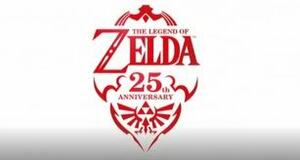
The Legend of Zelda is one of the best loved Nintendo franchises, over 25 years old and still finding new ways to thrill gamers. The significant number of Zelda releases means it boasts an incredible history and reputation, with each new entry’s adventure contributing its part to the lore of the series.
The recent launch of The Legend of Zelda: Skyward Sword continues the fine traditions of its predecessors: familiarity mixed with innovation, epic storytelling combined with small touches of characteristic humour and humanity. With the original inspiration for the series famously based on the imagination of Shigeru Miyamoto when discovering local caves, Zelda titles celebrate the joy of exploration, as well as the satisfaction of conquering quests vital to the world’s survival, or even just to help out a villager in need.
The Nintendo Life staff decided to pick ten memorable Zelda moments, progressing from the original game to the latest classic. With such a vast franchise it’s impossible to recount all of our memories, but the following represents a mixture of inspirational sequences and small, incidental doses of Zelda charm that have made us smile.
We’ve attempted to avoid major spoilers, though some story-based moments simply had to be included.
'It’s dangerous to go alone' – The Legend of Zelda
This quotation comes from the second screen of The Legend of Zelda on NES, where it all began. At the very beginning you don’t even have a weapon, yet the first cave that you enter is home to a mysterious old man, who simply utters these words and hands you a sword to help you on your adventure. The lesson for gamers playing the original for the first time: explore and you shall be rewarded.
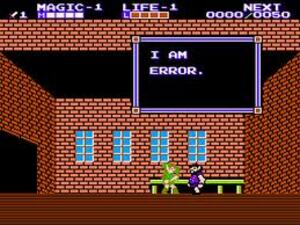
'I am Error' – The mysteriously named figure in Zelda II: The Adventure of Link
Not too far into Zelda II: The Adventure of Link you explore a village and, naturally, poke your nose into every house that you can find. In one room is a character who introduces himself by saying, 'I am Error'. It’s a classic moment that's notorious among gamers, with a common assumption being that this is, literally, an error manifesting itself in text.
Interestingly, there's a theory that Error was a deliberate name and that another character in the game, Bagu, was actually incorrectly translated from the Japanese word for 'Bug'. Some believe that by introducing characters called Error and Bug the programmers were sharing a joke through the game. It’s also worth noting that Error is actually an important figure in the adventure who later provides vital information for progressing in the game.
Taking Bow Wow for a walk in The Legend of Zelda: Link’s Awakening
Link's Awakening was the first Zelda title on the Game Boy, and has most recently been made available on the 3DS Virtual Console, a release of the exceedingly pretty Game Boy Color remake. One of many stand out moments comes when you’re invited to take Bow Wow — who is actually recognisable as a Chain Chomp as seen in many Mario games – for a walk. Not only is it a surreal moment to be walking such a powerful creature that behaves like a dog, but it becomes a very loyal companion that happily devours enemies and obstacles in your way. Progress is impossible without it, and for a short period it truly is Link’s best friend.
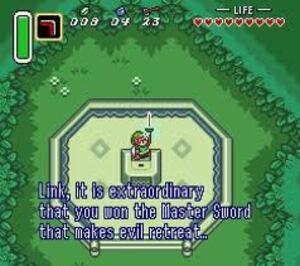
Gaining the Master Sword in The Legend of Zelda: A Link to the Past
The Master Sword is a big deal in many Zelda titles, an essential weapon against evil without which triumph is impossible. A Link to the Past on the Super Nintendo is a game full of wonderful moments and inventive gameplay mechanics, but we particularly enjoy retrieving the Master Sword from the forest. The build-up is tense and atmospheric, and the moment of triumph is greeted by a burst of glorious music, parting clouds and an area transformed with frolicking animals and sunlight. Grandiose and magical.
Throwing your sword into the mysterious pond in A Link to the Past
This is a spoiler, or a secret, or whatever you’d like to call it. It’s worth telling though, as anyone who has played through A Link to the Past should consider doing so again just to try out this trick. There is a moment near the end of the game where a particular item needs to be thrown into a mysterious pond to be upgraded by a faerie. Apart from this particular weapon many items don’t work, but just try throwing a sword in and see what happens…
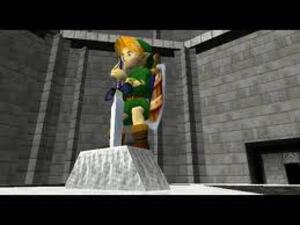
Removing the Master Sword from the pedestal for the first time in The Legend of Zelda: Ocarina of Time
Ocarina of Time redefined the series with revolutionary 3D gameplay and graphics, so playing through the original title on the Nintendo 64 is a fond memory for many gamers. A moment that epitomises the wonder of the experience is the first time Link removes the Master Sword from the pedestal in the Temple of Time. A cinematic swell of music is accompanied by wonderful imagery; it’s a moment that lives on as emblematic of Zelda storytelling in the age of 3D graphics.
The Zelda series has often allowed gamers to experiment and provoke interesting moments with their own imaginations, going all the way back to the sprite-based 2D titles.
Interacting with Cuccos in Ocarina of Time
The Zelda series has often allowed gamers to experiment and provoke interesting moments with their own imaginations, going all the way back to the sprite based 2D titles. In Ocarina of Time, meanwhile, there are various interactions with the chicken-like cuccos that stick in the mind. They can be used to descend slowly from high areas or can be retrieved for a worried owner. Whatever you do, though, don’t pick a fight with the poultry, as they will simply run you out of Kakariko Village in a flurry of furious flying feathers: being the Hero of Time will not spare you from their wrath.
The ominous approach of the moon in The Legend of Zelda: Majora’s Mask
Majora’s Mask is a follow up to Ocarina of Time on the Nintendo 64 that's often, unfortunately, overlooked or forgotten. That's a travesty, as it’s one of the most moody, imaginative and creative titles in the franchise. The game's intriguing premise sees Link striving to avert an impending doom, in the form of the moon on a collision course with the town, Termina. The continually looming moon is a daunting sight, a visual sign of the danger of failure in the quest.
An ingenious puzzle solution in The Legend of Zelda: Phantom Hourglass
Phantom Hourglass was the first Zelda title on the DS, introducing the concept of stylus controls and the creative possibilities of Zelda across two screens. One moment that truly shines as the epitome of imaginative puzzle design is the point where the solution is to actually close the DS and open it again. We won’t say where this happens, but it's a solution so left-field that it no doubt perplexed many gamers.
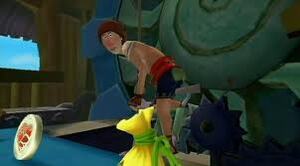
Being thrown out of Beedle’s flying shop in The Legend of Zelda: Skyward Sword
As you may have gathered from our The Legend of Zelda: Skyward Sword review, we rate the Wii-exclusive Zelda adventure as one of the finest games in the whole franchise. A feature that truly delights is the quirky behaviour of some of the characters that Link interacts with. A memorable example is Beedle’s flying shop: if you browse the items but don’t actually complete a purchase, Beedle will have his revenge…
Those are ten memorable moments that we feel typify the characteristics and appeal of The Legend of Zelda as a series. We’d love to hear all about sequences or subtle touches in Zelda titles that matter to you in the comments below. Please try to be sensitive and either be selective in your descriptions or, where necessary, exclude major spoilers.




Comments 74
That Phantom Hourglass moment was so mindblowing. I had nearly forgotten about it until now.
Ah Zelda... You Create So Many Memories...
That may have been the PH puzzle i got stuck on before i had to give the game back to my friend.
Bravo! A wonderful article, full of moments that really stand out in the series.
And, yeah, about the PH puzzle, I thought it was a bug or something, that prevented me from completing the game.
I don't usually like lists that hinge on nostalgia, but this one's pretty nice. The DS closing puzzle is one of the last things I would have included. I would have placed cucco interaction under the Link to the Past section. Finally, Zelda II's game over screen is far more memorable than Error.
Lost in Blue and... was it one of the Layton games? Or Trace Memory? Also featured closing the DS as gameplay mechanic.
The most memorable moment in Zelda for me has to be in Wind Waker when Tetra, y'know, and then the King of Red Lions, and then the black and white temple, and this is all extremely paraphrased and impossible not to expound upon without spoiling.
I certainly loved the part in Ocarina of time where you play a certain song in front of Darunia and how Link reacts to this afterwards. It was priceless and I was just smiling the whole time.
The Phantom Hourglass moment was less notable if you'd played Another Code (is that Trace Memory in the US? The one with the White Haired Girl on an island), which had a similar puzzle. Still made me grin though! I always liked saving Epona and leaping to freedom. Every time I do it; in 3D, Virtual Console or a replay on the old N64, it brings back so many memories of what was (for young me) a defining moment in gaming.
A yes, I remember that puzzle from Phantom Hourglass.
I think Windwaker had a memorable moment as well. Without revealing any spoilers, the final moment of the final battle was amazing. Even Game Informer said it was one of the greatest "Hell yeah!" moments in Zelda history.
Yes! these Moments! I remember them all lmao, except the Skyward Sword ain't play that yet.
And yeah, Wind Waker (My fav) had nice moments to though, and The Legend of Zelda NES. "It's too dangerous to go alone, take this!" haha :3
I played through all of Phantom Hourglass, and never ran into that puzzle. Was it part of a side quest?
I think I remember that puzzle in Phantom Hourglass. It didn't bother me too much, as once I couldn't figure it out I just got on a walkthrough to find the solution.
Minor Spoilers
The dying soldier in the alley in Ocarina of Time. Throughout the whole Young Link part, things are rather happy. Things haven't gotten dangerous yet. It really is a minor touch between two dramatic moments but for me, that's when the game gets serious. A man tried to stop Ganondorf and he payed for it. He dies telling you what you already knew. The quiet "He isn't moving anymore" if you try to talk to him again sets a rather quiet tone as you go into the Temple of Time.
Another moment in the game that was easy to miss that stood out to me was when you tell Mido about Saria. That was a well done scene. In a game where to be honest, the story wasn't always the best, its nice to see a moment like that.
Phantom Hourglass is really underrated. I agree with @WaveBoy. However, it didn't have a huge amount of memorable moments but it did have memorable characters. The way Linebeck matures is cool. I like how you get little bits of info about how Linebeck knows the pirate girl who I can't really remember the name of throughout the course of the game. The boss fights were memorable. I remember the frame rate drop while fighting that huge wooden guy... But seriously, the boss fights were really good in that game.
I can't say much about Skyward Sword because it came out last month so I haven't had the opportunity to have memories about it yet. The scene where Groose falls down to the surface world was unexpected and really funny.
I haven't played Wind Waker but I know a lot about it from LPs and videos and stuff. The Ganondorf death scene was rather powerful. I think that game was sort of powerful as a whole just due to the fact that they take a cartoon kid and make you respect him. He has to earn the right to be a hero in many ways in the game and in the player's eyes unlike a lot of Zelda games.
The scene in Link's Awakening DX where Link and Malin are sitting on the beach was cool. I'm pretty close to the end of that game and I don't want to beat it and make the Windfish wake up! D: It is one of the most memorable 2D overworlds I've ever played because it actually is fun to explore like the 3D ones. You aren't just walking across it to get to the next city or dungeon. Stuff happens, people are there. Plus the game has a great soundtrack.
There, it was long but a great series deserves it. I don't think I added too many spoilers.
Reading this at the same time as watching Minish Cap's credits after beating the game for third time
How many other people here figured the PH puzzle out by getting so annoyed that you closed the DS to take a break and then you come back and then...I know I did.
Game Informer put when Trace Memory did that as one of the best 10 video game puzzles. They said that Trace Memory did it before Phantom Hourglass so it deserves the nod. The Zelda series was loved too though. The bookshelf puzzle from ALttP was on there and the Lost Woods from Zelda 1 was first.
@Dodger: Speaking of Phantom Hourglass and Linebeck in particular, I remember the first time I played through the final battle and that happened (i'm assuming you know what I'm referring to, trying not to spoil things for others D: )... my heart absolutely sank. holy hell I felt so bad during the rest of that battle. Linebeck is my favorite :3
Oh that. Looking at his face for that split second was horrifying for reals.
Memories I've had with The Legend of Zelda: Playing Super Smash Bros. on the N64 as Link because I thought he was awesome. Yeah, I had a PlayStation childhood.
When I think of Zelda
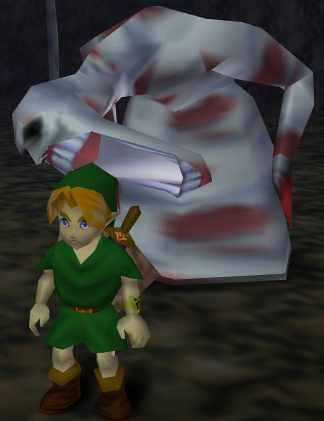
all I see is this...
IMHO the most memorable Zelda moment of all time is SPOILER ALERT when you get the Master Sword in Wind Waker and the flow of time in Hirule is restored. Magical moment! http://www.youtube.com/watch?v=aFHEQL2Xlkg
There are lots of moments both big and small. I whole-heartedly agree with the PH puzzle. Took me almost 15 minutes to figure it out.
I also have to say the ice temple dungeon in Spirit Tracks. It had some of the best uses of the boomerang yet.
On a more touching note, the moment I remember most was the tune of Ballad of the Windfish in Link's Awakening. Not only was it great to hear such a soothing melody come from Marin's mouth, but the moment you collect all the instruments to wake the windfish with the song my jaw completely dropped. I was completely unaware at the time that the system was capable of producing such beautiful music.
I remember that Links cap in Minish Cap was always interesting. Alsp the opening sequence of Oricle of Seasons/Time was interesting.
My memorable moments? 1. The scene in Oot when Ganondorf chases Zelda out of the town gates for real, seeing it in a dream at the beginning and then suddenly it really happens kinda shocked me.
2. TP's final bosses, SO EPIC!
3. When the screen said DAWN OF A NEW DAY in MM, that really gave me a sense of relief.
There's nothing which isn't memorable about the Zelda series. Let's say that the first time I played The Legend Of Zelda for the NES back in 1990 was one of the most incredible moments in my life; it felt so huge, it was unbelievable. Using the flute to travel and the raft to cross water were all quite new experiences for me. It was also a great feeling finding secret rooms, defeating these gigantic monsters and collecting parts of the Triforce (and the Heart Container of course!). The same can be said when I got my hands on A Link To The Past back in 1993; it remained my favorite Zelda until Twilight Princess came along. Link's Awakening is probably my favorite portable title ever, it was just incredible, especially the puzzles and it's great characters and cameos. I could go on for hours about it's music, influences and secrets but I'm in the middle of Xenoblade, so...if ya don't mind...
Oh, finding the last dungeon in The Legend Of Zelda was also quite fun, ghehehe....
My all-time favorite Zelda memory is the entirety of Ikana Valley and the Stone Tower Temple. Zelda at its all-time best, and it has such a creepy vibe unlike anything else I've ever experienced in a game before.
@TBD That was probably one of the best moments in PH.
PH isn't the best Zelda ever but it deserves a bit more respect then it gets. The Temple of the Ocean King wasn't that bad and it has a lot of cool characters. Sailing is fun and the remix of the WW ocean theme is pretty cool. The dungeons aren't always the most creative but the new ways that you use the items and the way it goes into 3D for the boss fights makes up for that. Plus they actually introduced a new race other then Gorons and Zora.
IGN had a list of most disturbing moments in Zelda games and the WW Ganondorf death scene is on there.
I honestly think the cute graphics in the cel-shaded games make the "scary" things in Zelda games actually scary. Partly because you don't expect it and partly because nobody likes bringing a kid into a dangerous situation. MM has a bit of that too.
Sometimes the music is what creates a memorable moment. The music in Gerudo Valley makes shooting women in the head that much cooler and Farewell Hyrule King is one of the best songs in the series for a rather powerful moment. Of course, the entire WW soundtrack is pretty awesome...
Wow, I could not forget that puzzle in Phantom Hourglass. It stumped me long enough to realize I needed a walkthrough. Closing the DS was so simple, yet so complex. Great read Thomas. Brought back a lot of fond memories.
Whoa...I just realized there's no mention of Twilight Princess or Wind Waker on this list. And yet when I was reading it, it struck me as perfectly balanced. This series is just too darn good.
LoZ - The boomerang is amazing in this game... freaken amazing
LoZ2 - Hard to say... but funnily enough, this whole game blows my mind. Even though it is a massive departure from the series, I've played this through more than any of the zelda games.
LoZ:LttP - the light world dark world stuff... at this point the player releases the true depth that went into the design of the game.
LoZ:OoT - the hookshot (WOW), the 3rd person perspective for the first time in a zelda series, everything about this game is a first.... playing projectile tennis with ganon. This entire game is amazing.
LoZ:MM - I'm stuck on the boss of the water dungeon. I would have to agree that the moon is pretty damn creepy in this game. It has an amazing atmosphere that departs from the series, yet still feels uniquely zelda-ish
LoZ:WW - Towards the end of the game, you go under the water. This was epic. I remember being shattered that there was only one more dungeon to go. If there had been 3 more dungeons at this stage along with a whole world to explore, this would have been my favourite zelda by far.
LoZ:TP - The cinematic where the wise men captured Ganon, the 'shadow' world towards the end, hyrule castle and... DOUBLE HOOKSHOT
And across all of the games.... the boss fights, particularly the games with 3D worlds.
And Phantom hourglass, the initial temple, which keeps unlocking further floors was some amazing level design. Phew... thanks for reading all that if you made it this far
LOZ: The dungeon music
AOL: The 'friendly' women in the towns
ALTTP: Bunny Link
LA: THIEF!
OOT: Watching the sunrise at Lake Hylia
MM: Anju & Kafei
TWW: Hyrule in black & white
TP: Midna at death's door
SS: Learning about Zelda's origins...whoa!
Can't think of anything for OOA, OOS, FS, FSA , TMC, or PH right now as I'm tired, and I haven't even started ST yet.
Epona?
Agree with other commenters: Why no Wind Waker?! And TP, for that matter.
Romulo is absolutely right about WW. Seeing the old kingdom of Hyrule frozen in time deep under the ocean was a staggering moment.
As for TP, becoming a wolf for the first time and finding yourself in that other dimension with Midna is hard to top. It cemented for me the sense that this Zelda game had a tone and sense of mystery unlike any other.
What about all the delightful moments in Minish Cap? You failed to mention this wonderful game! The BEST portable Zelda game ever
wow awesome ive played all zelda games and ya can't just forget those good memories...
Turning off Majora's Mask after beating it, deleting it from my Wii, and never having to play it again ... that's my favorite Zelda memory.
@grumblegrumble: The most delightful moment in Minish Cap would have to be...
The whole game!
...Or maybe the part when Link learns how to split in two.
What about that first time way back when when you stepped out into Hyrule Field in OoT? And the music played and your jaw dropped because it was so BIG and looked so GOOD? (Remember, it did look good back then! XD) And you knew you had barely started and you had this whole massive game to explore.
And then you got a talking to by an owl. Ugh.
@PhoenixCake
LOL. That is too funny.
Anyways, how did you manage to exclude Twilight Princess and Wind Waker but mention Phantom Hourglass AND Skyward Sword?
my most memorial moment in the zelda series is the final battle with Ganondorf in THE LEGEND OF ZELDA OCARINA OF TIME.....simply amazing
I have to say that strangly enough I bought Ocarina for the 3DS and its actually one that I missed since I was too busy for games while in Art School. Anyways, Its so awesome! But the thing thats creeping me out is the big fairy woman that give you the different majic abilities like fire and the spin attack. I'm playing with my kids watching and all of the sudden theres a wierd laugh and a naked woman with slime of something pops out of a fairy pond. Their just kind of wierd.
Beedle's complimentary ID...
@Bubby444: Mine too that scene there totally made Ganon seem badass. To often in games they go on and on on how the final boss is a baddonkey but in OoT when Ganondorf transforms into Ganon and you see him for the first time wielding those dual sword you just cant help thinking OMG what a badass lol.
umm how about the ending to Majora's Mask? you remember the little boy wearing the mask sitting next to a tree?
that game was seriously demented. that's why i like it
To anyone asking why isn't X game represented: this is a list of ten memorable moments. There have been more than ten Zelda games. Does not compute.
No one cares about Midna's transformation at the end? I was annoyed by her throughout the game, but turned around when she nearly died, then got annoyed again when I got the feeling I was being played.
Then we have the fact that you become mediator in a deteriorating love affair in Majora's Mask, or some schmaltz, while the earth is about to be destroyed.
Another thing that stuck was the Jabu-Jabu fish dungeon in Zora's domain and the final 3 minutes of Ganon Tower, with the Re-Dead and all.
I've always liked becoming deity Link in MM.
Great to see some many different memories being mentioned, our list was really a taster menu to get things started. We also tried to avoid including nothing but big story moments, as the idea for the article originally came from all of the funny little touches in Skyward Sword, so we wanted to include some of these.
In terms of 'why wasn't X ending' included, giving away the end sequences of games in detail is a bit of a spoiler. We already flirted with danger with a couple of them, but explaining endings to games wouldn't be fair on those yet to play these titles.
@Lobster I agree. Hell, the first few day to night sequences, with all the changes in the light and the appearance of stalfos and more enemies too.
The World Ends With You still has the best "close the DS" puzzle ever. And it's not even a puzzle in the traditional sense. Duck Amuck has the 2nd best.
I always thought the scene in OoT where you jump over the wall of Lon Lon ranch to escape was pretty awesome. I had a lot of fond memories of that game, but that one was one I remember as something special the first time I played it.
I have lots of good memories of Zelda 2 as well, but that's just more of the 'feeling' and locations of the game, as opposed to a big scene or something.
And yes, the underwater Hyrule in WW was amazing.
It makes sense for TP and WW to be on this list. Their greatest moments are major spoilers.
My most memorable moment with Twilight Princess? Hearing the nice music while carrying Midna to Hyrule Castle, being happy about the first song I actually liked in the game and then having it stppped many, many times for the boring battle theme. TP, not my favorite. Granted, I haven't finished it all but I know what happens to Midna and Ganondorf and stuff.
As far as personal memories, I'll always remember playing the Smash Bros. demo. It has 3 save files, one with Young Link with all the cutscenes skipped, one with Adult Link with all the cutscenes skipped and an empty one. Decided to try the Adult Link save file. Walked out of the Temple of Time and was killed by unknown monsters that made it so I couldn't move...multiple times. Went back to playing Young Link.
Then when I actually played the game, I stepped onto Hyrule field for the first time and thought that the stalchildren were the dreaded redeads that everyone was talking about that would freeze you...It was a fun night spent swimming in Hyrule Castle moat.
Fellow Zelda fans, please head on over to G4.com and vote for Skyward Sword. It needs to win Game of the Year, but it'll need all the votes it can get
Zelda GOTY vote
Back on topic, Blizetta from Twilight Princess and the well in Kakariko Village from Ocarina of Time would have to be my top memorable moments
@Dodger: Nintendolife said they were trying to AVOID spoilers, and that's why TP and WW couldn't make the list. I also played the Smash Bros. demo. The adult Link portion was boring, aimless, and completely unfit for marketing purposes. They would have been better off not including it and sticking to the Deku Tree save file you mentioned.
The part in Wind Waker where the Tower of the Gods arises from the depths of the ocean. After placing the pearls on the three pedestals on the Triangle Isles, Link is hurled against the walls of this memorable dungeon. Epic, with a touch of humour.
When you get launched off of Tetra's ship in WW. And when you gather all the flames to power the Master Sword in SS.
I completely agree with the PH memory. I remember being so frustrated when I first encountered that puzzle, so I closed my DS and went to play something else. When I opened it up I was surprised that the seal had transferred itself over to the map!
@uel Major facepalm moment. That was what I meant to say. I even read through it before posting so how did I miss that?
The Adult Link portion was the actual game after the cutscenes where Link wakes up. Which means you have no idea what is going on or where to go other then that Shiek tells you to go to the Kakariko Village Training Center and there is an area with a weird camera angle and enemies that jump on you and kill you before you can attack them. Makes more sense when actually playing the game.
What's the Smash Bros demo?
Brawl had unlockable demos of vc games. The demos were called masterpieces, and one was for Ocarina of Time.
The day a zelda game gets a bad score by pros is when apple rules the world....
My favorite memory so far is the ending of Wind Waker. Ganon has been after the Master Sword for a long time now and Link gave it to him!
I was going to say the frozen time black and white temple in Wind Waker but I see many already have. How about when you get sucked into Jabu-Jabu's belly?
I'm glad there are articles like these on NL that let me remember these fond memories.
Anyway, here are that stick out the most for me:
@uel
Nice one.
For good or bad, the Zelda CD-i games deserve a mention. Who can forget those ... ever? D:
@Viewtiful_Joe: Sorry for my ignorance, but what exactly are you complementing me for?
Nice article! The Zelda series has quite some moments, like the dancing Darunia in Oot, or saving Romani ranch in Mm. In Skyward sword there is also something very cool. I won't spoil it, but when you get a letter from Cawling there is a good and a bad option. I took the bad option! That will teach him!
Four Sowrds is fun too
My most memorable moment was in Spirit Tracks where Link & Zelda held hands at the end. ^-^
Sneaking passed the enemies in a barrel in the forsaken fortress, there has never been a more tense moment in zelda. The sneaking doesn't even come close in SS.
I agree with the black and white as well.
In MM meeting Tingle for the first time was surreal (that was his first apearance wasn't it?)
Oh yeah, meeting the fairy queen in WW (was anyone expecting what she looked like?)
Hyrule in Wind Waker was epic and beautiful.
Also pretty much every part of Majoras Mask was memorable
Ah...Zelda. Good times.
Spirit Tracks was my favorite for the DS.
Phantom Hourglass was a little on the easy side.
But I liked Linebeck and Ciela.
I am a Zelda fan since the first NES Console was invented to put on you television i think that they are the best games if you need adventure in your life because you want to be there with link fighting the bad guys i missed the original Zeldas because i would like them to come back so that people can play them again and see the fun that i had when you be able to clock them and i hope to get them on 3ds because i do not have a wii
Show Comments
Leave A Comment
Hold on there, you need to login to post a comment...